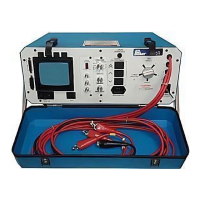
Do you have a question about the Baker Instrument Company D12R and is the answer not in the manual?
| Brand | Baker Instrument Company |
|---|---|
| Model | D12R |
| Category | Test Equipment |
| Language | English |
Details limited warranties for Baker/SKF brand products and disclaimers regarding product use.
States that other trademarks and service marks belong to their respective owners.
Provides general and specific safety precautions for operating and servicing personnel.
Defines Danger, Warning, and Caution terms used in safety notices.
Highlights critical safety warnings regarding electrical shock and hazardous operations.
Instructions for cleaning the unit using a damp cloth, avoiding submergence in liquids.
Provides information on obtaining technical support and locating authorized service centers.
Explains how to connect and use accessories like the footswitch and optional safety lights.
States that there are currently no intermittent operation limits for the AWA unit.
Details the acceptable operating positions and ventilation requirements for the unit.
Lists the items to be removed from the shipping boxes, including the unit, power cord, and manual.
Specifies the unit's intended use in environments with non-conductive pollution and condensation.
Details the unit's power needs, including voltage, frequency, current draw, and fuse type.
Outlines operating temperature, altitude, and humidity limits for the tester.
Details the functions of each button, port, and indicator on the instrument's front panel.
Adjusts the up/down positioning of the surge wave pattern for optimal display.
Adjusts the side-to-side positioning of the surge wave pattern for display.
Selects the type of test: Surge, HiPot, resistance, AT101, or auxiliary/power pack testing.
Adjusts sweep rate for surge display, controlling zoom on the wave pattern.
Illuminates when voltage is applied during a test.
Activates high voltage output for surge or HiPot tests; must be held during test.
Configures test leads for Surge, HiPot, or grounding connections.
Allows hands-free operation of the tester via a connected footswitch.
Insulated test leads provided for contacting windings, rated to 40 kV.
Two sets of leads with current and sense wires for resistance measurements.
Explains the screen display elements: menu bar, message area, wave pattern display, and setting indicators.
Covers ventilation, stacking objects, moisture, and dirt precautions for unit operation.
Details the self-check process, screen visibility, ground detection, and troubleshooting contacts.
Explains how the footswitch enables hands-free operation, aiding in tasks like rotor spinning.
Suggests a specific order of tests: Resistance, Meg-ohm, HiPot, and Surge.
Checks for resistance imbalance between phases and discrepancies with nameplate values.
Measures insulation resistance using a test voltage based on motor operating voltage.
Explains the DA test as a short-duration PI test, useful for motors 50-200 HP.
Details the PI test for measuring insulator polarization ability, used for motors >= 200 HP.
Applies a higher test voltage to detect ground wall insulation damage via leakage currents.
Detects turn-to-turn shorts by observing waveform jumps as test voltage increases.
Provides formulas and tables for recommended HiPot and Surge test voltages.
Lists relevant industry standards for testing rotating electrical apparatus.
